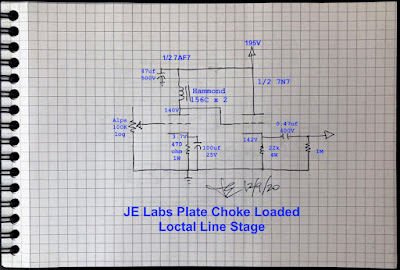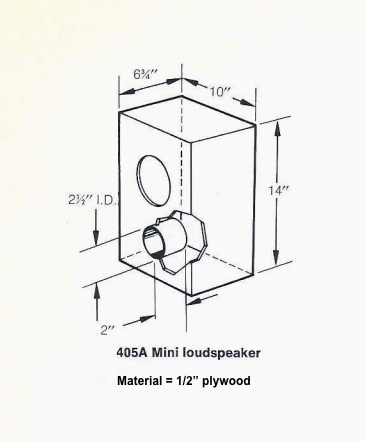Friday, July 21, 2023
Friday, July 7, 2023
Japanese Idler-Driven Turntable Part 4: Realistic Mark-7
Friday, June 23, 2023
JE Labs Plate Choke Loaded 76 Line Stage Preamp
I acquired this pair of James JS 4120N, 200H @ 15 mA nickel plate chokes from Keith Tan of Euphonia Audio in late '04. Due to my busy performing and teaching schedule back then, they remained boxed up close to two decades.
After going home with me to Manila and back stateside, I finally found time to try the JS 4120Ns in my preamp. After adjustment of voltages and operating points, I was impressed by the increased detail and resolution brought forth by replacing the Allen-Bradley plate load resistors while retaining the sonic aura I've come to treasure from my Bruce Berman-derived 76 > 1/2 6SN7 line stage circuit from Sound Practices Issue 13.
Unfortunately the JS 4120Ns have been out of production for quite a number of years. 😞
!!!WARNING!!!
The voltages in this project are potentially lethal! Proceed at your own risk!
 |
| NOTE: According to the 7N7 data sheet, it has a maximum cathode to heater (filament) voltage rating of 90V. To get around the 142V at the cathode, I lifted the filament potential 65V above ground via a voltage divider network in the B+ supply. Hence, 142 - 65 = 77, which brings it back to spec. |
 |
| 100 Hz, 1 kHz and 10 kHz square wave output from 2 x Hammond 156C plate choke loaded 1/2 7AF7 + 1/2 7N7 cathode follower |
I tried the budget-friendly Hammond 156C plate load chokes in the circuit above on my loctal preamp as well as on my main preamp with the 76 line stage below.
Detail improved but I missed the micro dynamics and organic quality in the midrange of the JS 4120Ns. That said, I'm now using this topology in the nosTDA1541tube DAC in my main hifi set up. Meanwhile the loctal preamp line stage has been reverted back to its original state with Allen-Bradleys.
 |
| NOTE: This choke saturates instantly past 8 mA! |
Since the Hammond 156Cs are easy on the wallet (just like the 125ESEs I wrote about decades ago😉), why not try and judge for yourself? If you hear potential, then proceed to the nickel plate choke-equipped circuit below.😊
 |
| Custom wound Intact Audio 250H nickel plate chokes |
I was so impressed with Dave's nickel plate chokes👏 such that I ordered a pair for myself so I could use the JS 4120Ns for other tubes and circuits. I also confirmed that in order to get the most out of the plate load choke topology, one needs a competent winder, and nickel should be part of the equation!
 |
| Even if I always used more rugged 6SN7 GTA and GTB types in the cathode follower section, when I built this preamp over two decades ago, the power supply was configured so that the filament potential was about 75V above ground. |
I've always admired the sound (or more appropriately, the lack thereof) of nickel permalloy, having owned the Tamura F7002 and Tango NY15S since the 90s. Even if these output transformers are hefty beasts, which helps the low frequencies, it's not their bass response that captivates the listener. Instead, they present a very natural midrange replete with rich and harmonious overtones, which are virtues I also hear with Finemet.
 |
| 100 Hz, 1 kHz and 10 kHz square wave output from an Intact Audio nickel plate choke loaded 76 + 1/2 6SN7 cathode follower |
After praising the merits of exotic core material, I wouldn’t want readers to get the impression that nickel or Finemet are the quintessential elements to great sound. Tube choice, circuit topology and operating points, parts selection, etc. not to mention the synergy of components in the hifi chain, all contribute to the sonic stew. That's why I encourage audio hobbyists to listen and experiment so that they can carve their path towards their own musical satisfaction.
Although this video is merely a proof of concept, I got inspired and used my Sony A7II + Voigtlander Ultron 28mm f1.9 LTM lens mounted on a tripod rather than my usual iPhone. So plug in your Koss Porta-Pros or Sennheiser HD6XXs and (hopefully) enjoy!🎶🎹🎻
Maybe 🤔 I'll talk about my plate choke adventures with SE amps next time!😉
Friday, June 9, 2023
Cork Turntable Mat
Rubber hardens as it ages and this is exactly what happened to the rubber mats originally supplied with my Garrard 301, 401, Thorens TD124 and other turntables. I'm aware that modern reproductions are available, but I wanted something more affordable and practical. So I surfed and found a 3-pack cork mat with an LP label indentation for $12 on Amazon.
Does this mat make the sound better?🤔 Hmm...frequent visitors to this blog know better that after several decades in this hobby, I've grown averse to typical audiophile hair-splitting.😉
However, I'm happy to report that a few LPs from my collection which are slightly dished or warped now lie flat. That's good and I like the sound.
Try it and hear for yourself!😊
Happy Spinning!🎻🎷🎶
Friday, May 19, 2023
Kutztown Radio Show Spring 2023
Tish and I were delighted to have our dear friend Tony, organizer of the annual November Hi-Fi Show event in Manila, as our house guest this past week. Even if he presents the latest in high end audio, his hifi set up is quite eclectic and chosen by ear. It consists of bespoke SE-DHT amps, horn speakers using classic Altec drivers, a grease bearing Garrard 301 + contemporary components for digital streaming and headphone listening. He makes it a point to also feature local DIYers in his annual hifi event by subsidizing their demo rooms.
Thus, the Kutztown Radio Show is very much his kind of scene too!
More crate digging, this time for LPs
at Young Ones Records in downtown Kutztown
Saturday, May 6, 2023
Saturday, April 15, 2023
Saturday, April 1, 2023
Altec 405A
This ain't no April fool's joke!😆
Since the mid-60s (scroll down to pdf page 31), stateside audio experimenters have been trying to squeeze the last ounce of performance from the Coral/Sony "Holey" and Foster/Fostex FE103/Realistic 40-1197 family of 4" drivers. Meanwhile, Japanese aficionados like Old Joe (above), whom I follow on YouTube, kept snapping up Anaheim-manufactured Altec 405As in multiple quantities to stuff into their mini A7 VOTT projects.
Because of the dearth of units left in the States and my indifference towards engaging in a bidding war versus fellow Asian hobbyists, I patiently hunted them for 20+ years via other channels.
 |
| Altec 405A specs |
The 405A is a 4" 60-15,000 Hz wide range driver with a sensitivity rating of 92dB/4ft/1W. It's equipped with a massive Indox magnet that's almost the same diameter as its cone.
IMHO and experience, Altec cabinet plans always deliver sonically. Aside from a full understanding of the physics of sound, their engineers used their ears as the final arbiter in a design brief. To me, that trumps any design completely derived from a mathematical formula or computer simulation. So I asked my buddy @ Hommage Audio to fashion a Bonsai pair of Altec 614-style boxes based on the above dimensions.
 |
| Interior stuffed with Dacron |
For sentimental reasons, I have a pair Realistic Minimus 8s on my test bench. I always thought they were above average, although not extraordinarily special. Same deal with the "Holey Frame" drivers I pulled out of a Sony TC500A RTR machine. To my ears, both FE103 derivatives have an upper midrange resonance, which require an EQ/contour network to make them more listenable.
 |
| 614 style 405A cabinet |
I found the 5.25" Realistic 40-1354A more impressive in spite of its narrow band whizzer honk. Back in the 90s, I played with it in a ported box similar in size to the above Altec 405A cabinet, as well as in a TQWT. Both speaker projects came from the book Designing, Building, and Testing Your Own Speaker System by David B. Weems.
 |
| Silbatone box + 755C and 405A in a 0.4 cubic foot ducted port box |
Spoiled by years of exposure to Altec 755As and 755Cs in open baffles or 2 cf boxes, and more recently, in Silbatone cabinets, I considered this Altec 405A + Bonsai 614 style enclosure project as a mere novelty experiment.
As soon as I hooked them up to my near-field hifi system, I was pleasantly surprised that they play like their bigger brothers, albeit at a reduced scale.
It's physically impossible for the 4" cone of the 405A to extend much below 90 Hz, but the roll off is gentle and there's enough harmonics to suggest bass lines. I hear a slight trace of peakiness in the presence region. For my taste though, an EQ filter isn't necessary.
Although the Altec 405A can't replace the Altec 755C (much less the 755A) in my near-field set up, its midrange depth, micro dynamics, detail resolution and overall tonal balance makes it worthy of the Altec badge!👍😊












.jpg)





























